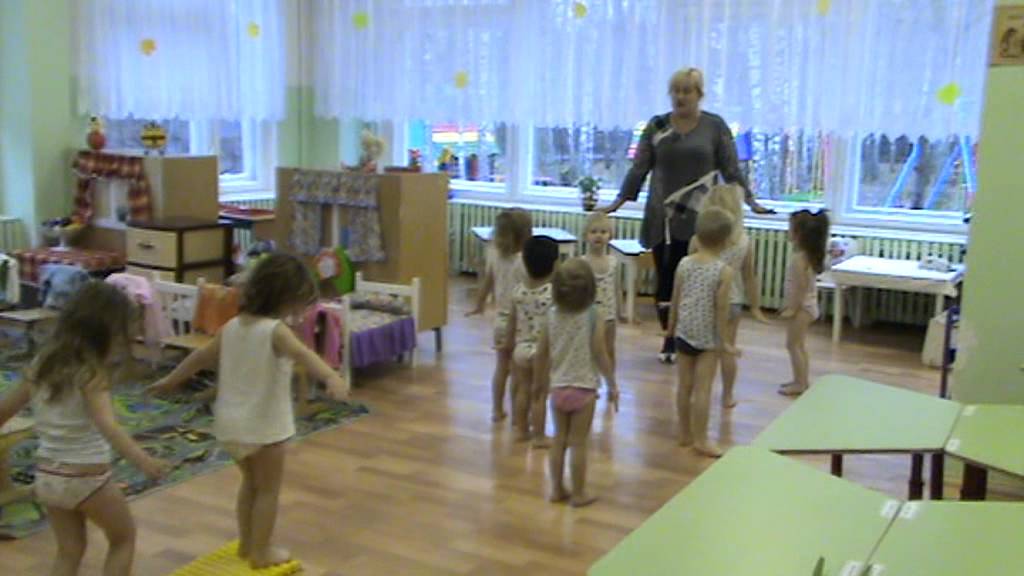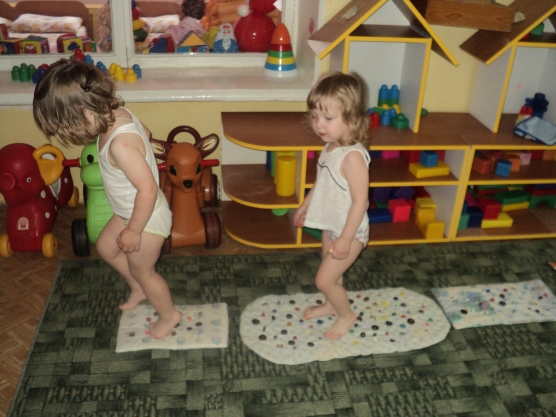We carry out awakening gymnastics in the second junior group
The importance of sleep for the full development of a child is difficult to overestimate. But correct awakening is also very important for the baby to spend the rest of the day in a good mood, which means he is active and cheerful. Children of the second youngest group, due to age characteristics, rather difficult transition from a state of rest to physical activity. The teacher is faced with the difficult task of choosing a suitable set of exercises, combining physical activity.
Definition of the concept of "gymnastics after sleep"
Gymnastics after a nap is a set of exercises that organizes a leisurely transition from calm sleep to continued activity, which is carried out with rhymes and slow, quiet music. For children of the second youngest group, that is, 3-4 years old, the complex should have the character of a game with a plot, where a familiar character acts, which is a model for repeating all actions after him.
Physical activity is distributed in such a way that the complex includes exercises:
- to perform lying in bed (stretching, swinging legs and arms);
- an active block (running, squats, as well as gymnastics elements for fingers, etc.);
- on the development and improvement of the respiratory system.
The total exercise time is 5-7 minutes.
It is worth noting that the selection also depends on the general strategy of the educational program of the preschool institution. So, if hardening groups are practiced in kindergarten, then children perform most of the exercises in the open air at any time of the year.
How the baby wakes up determines his mood and physical condition for the rest of the day.
Post-sleep gymnastics goals
Like all program elements of working with children in kindergarten, the main task of conducting classes is to preserve and strengthen health. In this context, the goals of post-sleep exercise are:
- tone the muscles;
- improve mood;
- prevent curvature of the spine, the development of flat feet;
- instill in babies the habit of warming up after sleep.
It is important to consider that in the exercises after sleep there should be no sudden body movements, otherwise muscle stretching, increased excitability and dizziness cannot be avoided. In the second younger group, the emphasis is on barefoot walking and lifting.
Types of awakening gymnastics
Usually, educators try to make up a complex that is aimed at realizing all the goals of the warm-up. But in the educational plans of many kindergartens, only certain types of gymnastics are included, aimed at solving a specific problem. In this case, planning is made for a month. In other words, for example, September - children do warm-up in cribs, self-massage; October - work on simulators or in a gym with sports equipment, etc. One can distinguish such types of invigorating gymnastics as:

Rules of conduct

In order for children to maintain a positive emotional attitude, you need to adhere to the timing framework.
- Exercise in bed - 1.5–2 minutes.
- The loads of the active block and breathing exercises - 2-3 minutes.
- Hardening procedures, if any, 3 minutes.
Awakening gymnastics card file
As already noted, the goals that are determined by invigorating gymnastics can be achieved by alternating a combination of different types of gymnastics (usually after half a month). For the second youngest group, it is rational to use a combination of two or three types, since in this case it is easier to draw up a single plot for the entire set - that is, to satisfy the main requirement for carrying out such health-improving work: put physical activity in the form of a game. The composition of the combinations of exercises is in accordance with the planning of work with children of a particular group.
Exercises in bed and music rhythm block
The most common type of combination: gymnastics, poetry and music. Let's give an example of several complexes of such gymnastics.
- Exercise "Stretching".
- Lying on your back, we stretch our arms along the body.
- Inhale and at the same time stretch with the handles up, and the heels forward.
- We return to the starting position and exhale.
- Exercise "Catch a mosquito"
- Lying on your back, spread your arms to the sides.
- We do cotton in front of the chest.
- We return to the original pose.
- Exercise "Bicycle".
- Lying on your back, bend your knees.
- We simulate cycling.
- We carry out 10-12 seconds.
- Exercise "Musicians".
- We play the accordion
Clap our hands loudly.
(Children clap). - Our legs: top, top.
(The kids are stomping). - Our pens: clap, clap!
(Clap again). - We lower our palms down,
(We relax our hands and lower them along the body). - We have a rest, we have a rest.
- We play the accordion
- Exercise "Funny legs".
- Higher legs! Top, top!
(Children stomp.) - More fun! Gop, gop!
(They jump up). - Bell, don, don!
(They make a movement with their hand, as if there is a bell in it). - Louder, louder, ringing, ringing!
- Gop, horse, gop, gop!
(They jump up). - Whoa, horse:
Stop, stop!
(They stop and lower their arms along the body).
- Higher legs! Top, top!
Instructions for general developmental exercises and self-massage:
- We lay on our back.
- We turn our head to the right, to the left.
- We stroke hands, tummy, legs, heels.
- We bend our legs, wrap our hands around our knees and gradually straighten our legs.
It is interesting. Combinations of different types have one feature: the first in these sets will be exercises in bed.
Poem for exercise in bed with elements of gymnastics for the respiratory system.
- The bird sat on the window,
A cat meows in the yard -
They decided to wake us up.
Everything! The quiet hour is over! - Wake up kids I want
invite you to play hide and seek.
(Children lie on top of the blankets.
Calm music sounds.
Children perform movements according to the text). - Our sleepy palms
Woke up little by little
They played hide and seek -
Fingers clenched into a fist. - Toes on our feet
They know all the paths in the park.
They check - where are the heels,
And they play hide and seek with us. - We are almost awake
Our hands reached out
Waved over the sheet
Together they hid behind the back. - We will hook the handles into a "lock"
Over my head.
Right, left elbow
We will bring it in front of us.
The knees don't want to sleep
It is high time for them to get up. - We put out our knees
The legs were quickly straightened.
Our mouths are silent
We train the tongue:
We will hide it and show it.
"Good day!" - we will say loudly. - Let's breathe deeply
Blow out the air with a noise.
Our noses woke up
We smiled at each other!
(stand on the rugs next to the crib).
Instructions for the Grow Big Exercise:

Summary of gymnastics in the second junior group, author Ershova Irina
Usually, educators use complexes that have a plot basis:
- Educator: “Children, it was interesting to watch you while you were sleeping. Someone sniffled like a little kitten, someone stretched in a dream like a fox cub, someone buried himself in a pillow like a little bear cub. Let's now draw some of the animals with our exercises. "
- Gymnastics complex.
- "The beasts are awake."
I. p. - lying on your back, arms along the body. Yawn and stretch well. Repeat several times; the pace is slow. - Educator.
Guess the riddle:
In the forest in cold winter
He walks angry, hungry.
He clicked his teeth!
It's gray ... (wolf) - "Greetings to the wolf cubs."
I. p. - lying on your back, arms along the body. Bring your arms to your chest, then stretch them forward. Return to and. n. Repeat five times; the pace is moderate. - "Owl".
I. p. - lying on your back, one hand lies on the stomach, the other - on the chest. Pulling in the stomach - inhale, protruding the stomach - exhale. Exhaling, pronounce "f-f-f-f" loudly. Repeat four times; the pace is slow. - "Dexterous monkeys".
I. p. - lying on your back, arms along the body. At the command of the teacher "tummy" to turn on the stomach. At the command "back", turn onto your back. Repeat five times: moderately at first, then quickly. - "The growling of bears."
Inhale through your nose. As you exhale, pull "mmm-mm-mm", while tapping the wings of the nose with the fingers of both hands.
- "The beasts are awake."
- Educator: What a wonderful zoo we have turned out. You not only beautifully and correctly showed the proposed animals, but everyone has already woken up (children perform hardening procedures).
